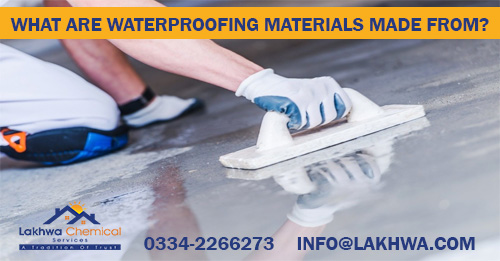What are Waterproofing Materials made from?
Have you ever wondered about the mechanism and behavior of waterproofing materials? Well, for starters, the solution is composed of various elements and compounds, such as Kaolin, Marble Dust, Silica Sand, Lime, Sodium Chloride, or Calcium Chloride. Organic composites, such as styrene-butadiene, acrylonitrile-styrene copolymers, and vinyl-toluene are also mixed for added durability.
Different Types of Waterproofing Materials
Polymers and Resins
Polymers and resins are the core ingredients of waterproofing chemicals (sheet and membrane). These materials provide elasticity, durability, and adhesion to the applied surface. Some common polymer types used in waterproofing include:
- Polyurethane (PU): PU polymers are widely used in liquid-applied coatings and sealants. They form a flexible and seamless barrier that can withstand movement and environmental stresses. PU-based waterproofing materials are used in roofing, basement waterproofing, and industrial applications.
- Polyvinyl Chloride (PVC): PVC is a thermoplastic polymer used in the manufacturing of waterproof membranes and sheets. These membranes are resistant to water and chemicals, making them suitable for roofing systems and below-grade applications.
- Ethylene Propylene Diene Monomer (EPDM): EPDM rubber is a synthetic elastomer renowned for its excellent weather resistance and flexibility. It is used in waterproofing ponds, basins, and closed structures.
- Acrylic Resins: There are three types of acrylic resins:
- Thermosetting
- Thermoplastic
- Water-borne
These solutions are composed of methacrylate and acrylate monomers, derivatives of acrylic and methacrylic acid. They are beneficial for reinforcing surfaces and dental substances, and fixing prosthetic devices. Acrylic resins provide resistance to weather, hydrolysis, color retention, and UV.
Read More
What is the Best Time for Waterproofing?
Which Materials Prevent Heat Transfer?
Bitumen
Bitumen, also known as asphalt, is a traditional waterproofing material used for different purposes. It is a viscous, black, and sticky substance derived from crude oil. Bitumen-based waterproofing materials are used in built-up roofing systems, where multiple layers are required to develop a strong waterproof barrier.
Cementitious Waterproofing
Cementitious waterproofing materials are composed of a blend of cement, sand, and chemical additives. When mixed with water, they form a reinforced slurry that is applied on concrete surfaces. Cementitious waterproofing creates a dense, waterproof layer that becomes an integral part of the concrete structure. This type of waterproofing is used in basements, swimming pools, and below-grade applications.
Bentonite Clay
Bentonite clay is a naturally occurring absorbent clay that expands upon contact with water. Bentonite sheets or panels are placed against the structure, and, when exposed to moisture, swells to form a watertight seal. Bentonite-based waterproofing is used in foundation walls, tunnels, and other construction projects.
Silicates and Silicones
Silicates and silicones are inorganic waterproofing materials known for their ability to penetrate concrete and masonry surfaces; they react with minerals in the substrate to form water-resistant compounds. Silicate and silicone-based waterproofing products are applied in commercial and industrial structures.
Read More
Properties of Polyurethane Foam
What are the Three Types of Basement Waterproofing?
Advantages and Disadvantages of Crystalline Waterproofing?
Rubberized Asphalt
Rubberized asphalt is a blend of asphalt and recycled rubber particles. This substance enhances flexibility and crack resistance of the waterproofing material. Rubberized asphalt can be applied on vertical or horizontal structures, such as plaza decks, green roofs, tunnels, planters, and more.
Modified Polymer Membranes
Modified polymer membranes are manufactured by mixing bitumen or PVC with polymer modifiers. These modifiers improve the material’s elasticity, flexibility, and overall performance. Modified polymer membranes are used in roofing applications, including single-ply membranes like TPO (thermoplastic polyolefin) and APP (atactic polypropylene) modified bitumen.
Conclusion
Waterproofing materials are essential for construction and manufacturing industries. These coverings provide protection against water damage and ensure the longevity of structures and products. The layers are composed of various components, such as polymers, resins, bitumen, cementitious compounds, clay, and rubber. The choice of waterproofing material depends on the specific application, environmental factors, and the desired performance.
Advancements in materials science have led to the development of innovative waterproofing solutions that offer enhanced durability, flexibility, and environmental sustainability. As for now, users can expect effective and eco-friendly waterproofing solutions at their disposal.
Connect with Lakhwa Chemical Services for a survey. We’re the best in the business!


Leave a Reply
Want to join the discussion?Feel free to contribute!